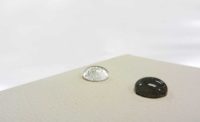Row after row of glossy black boxes hum away on an acre of land between a cornfield and the banks of Delaware's Red Lion Creek. "It's basically a fuel-cell farm," says George Gottuso, senior project manager with Hill International. "Right now, it's delivering 5.8 megawatts to the utility."
These refrigerator-sized cabinets are Bloom Energy Servers, natural-gas-powered fuel cells manufactured and owned by Bloom Energy, Sunnyvale, Calif. Each energy server contains a stack of solid-oxide fuel cells, made with Bloom's patented process and design.
One of the fuel cells, roughly the size of a large postcard, generates 25 watts of electricity using natural gas and steam in a continuous chemical reaction while emitting some carbon dioxide, heat and volatile organic compounds (VOCs). Stacked high in a cabinet, the fuel cells form the energy server, which can generate 200 kW of power 24/7, requiring only a constant feed of natural gas and about 200 gallons of deionized water at start-up.
Already delivering power to the local electrical grid owned by PJM as part of a deal with utility Delmarva Power & Light Co., the estimated $40-million Red Lion Energy Center eventually will produce 27.5 MW. Project and program manager Hill International believes this rating will make Red Lion the largest fuel-cell installation in the world as measured by generating capacity.
Red Lion's first phase finished in December, after just three months of construction. "We worked around the clock. We had a window of five days where we could get it tied into the substation," says Gottuso. In nearby Brookside, Del., a 3.5-MW fuel-cell installation is already up and running.
The project is rushing to meet an end-of-the-year deadline, installing fuel cells assembled at an unfinished, 200,000-sq-ft Bloom manufacturing plant in nearby Newark, Del. That plant is seven months into a tight construction schedule. "When we did the schedule for the plant, it had 50% of tasks on critical path," says Mark D. Dickinson, Hill vice president and owner's rep. Both projects use a mix of design-bid-build, design-build and "IPD lite," he notes.
Worth nearly $100 million in total, these three projects are Bloom's first major investments outside of California, and the motivation may be favorable deals with power utilities. As a Silicon Valley start-up, Bloom has relied on venture capital to drive its research and business since its founding in 2002. On its board, the firm boasts investor and venture capitalist John Doerr of Kleiner Perkins Caufield & Byers as well as former Secretary of State Gen. Colin Powell.
 |
| SRINDAR |
Surviving on venture capital is normal in the fuel-cell world, according to fuel-cell expert and journalist Peter Hoffmann. "It's an uncertain future with uncertain prospects. As far as I know, none of the major fuel-cell companies have made any [profits] so far."
Electricity-producing fuel cells were first developed in the 19th century, and commercial fuel-cell manufacturers have been around for decades. Bloom uses solid-oxide fuel cells, which, unlike many others, run off natural gas instead of pure hydrogen. According to Bloom, its fuel cells require no precious metals, corrosive acids or molten materials.
















Post a comment to this article
Report Abusive Comment